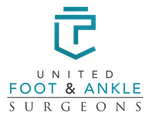BUNIONS
A bunion is a deformity characterized by lateral deviation of the big toe. As pressure is applied, the tissues around the joint may become swollen, red, stiff, and tender; the great toe is forced inwards towards, and sometimes under or over, the other toes. Over the years the characteristic bony bump becomes increasingly prominent. Over time arthritis will develop in the joint. Bunions can also occur on the outside of the foot near the little toe. This is called a “bunionette” or “Tailor’s Bunion”.


ANATOMY
Bunions are usually associated with a lateral deviation of the big toe toward the second, and deviation in the angle between the first and second metatarsal bones of the foot. The sesamoid bones found beneath the first metatarsal head may also become deviated over time as the first metatarsal bone drifts away from its normal position.
In addition to causing pain and discomfort, the changes that bunions make to the shape of your foot can make it hard to find shoes to wear,and even make walking difficult. The big toe joint is very important during the gait cycle for pushing off the ground. With this imbalance of the joint there is a loss of the proper range of motion leading to an inefficient gait.
CAUSES
Biomechanics: Bunions develop from abnormal foot structure and mechanics, both of which are inherited features. People with flat or pronated feet appear to be more prone to instability of the big toe joint and have a higher incidence of bunions.
Footwear: Certain types of footwear such as high heeled or ill-fitting shoes can contribute to the development of bunions. That is why bunions are more common in women than men. Improper footwear can exacerbate the problem caused by the original genetic structure.
Injury: Injuries to the foot can also be a factor in developing a bunion. Some activities (eg ballet dancing) put added pressure on the joint and may increase the chance of bunions developing.
A number of other factors are known to play a role in the cause of bunions: Diseases such as cerebral palsy, arthritis, specifically the inflammatory arthritides.
SYMPTOMS
Deformed shape: Bunions exhibit a deformed bumped curve at the joint of the big toe, pushing the toe towards the lesser toes.
Redness and Inflammation: Redness and swelling at the big toe joint are also usually present.
Pain and tenderness: There will commonly be pain in the toe joint and sometimes cramping in the toe or foot. The bursa (fluid-filled sac) on the inside of your foot at the big toe joint may also become painful and tender to the touch.
Numbness: Tingling, burning or total numbness in the big toe joint may be present.
Decreased motion: Immobility or movement restriction at the big toe joint is common.
Corns and Callus formation: A painful callus can develop on the side or bottom of the big toe or big toe joint. A corn may be present between the big toe and second toe from the pressure caused by the bunion moving the toes
Patient shares her experience of minimally invasive bunion surgery during 3 weeks of her follow up.
TREATMENT
NON-SURGICAL TREATMENT:
Padding and Strapping: The doctor will examine your foot and provide you with options to properly pad the painful area to reduce friction and minimize pain.
Corticosteroids: Injections of steroids may be administered if the inflammation is severe to decrease inflammation.
Functional orthotics: Often prescribed by your doctor to help control foot function, relieve pressure on the joint and decrease symptoms. Possibly this will prevent worsening of the deformity.
Appropriate Footwear: The doctor may suggest supportive shoes or modifications for your foot type and activities.
Activity modifications: Avoiding certain strenuous foot activity may be advised, possibly slowing the development of bunions and bringing relief to those already formed.
Icing: You may treat the affected area with ice packs daily, resting them comfortably and gently massaging with an ice pack. It is best to ice only 15 minutes at a time.
Medication: Take over the counter anti-inflammatory such as ibuprofen or acetaminophen to reduce inflammation and manage pain.
Spacers and padding: The doctor may recommend you use toe/foot spacers to improve alignment and prevent painful rubbing or padding to prevent friction.
Conservative treatments for bunions are often limited because they cannot correct the bone deformities and shift in the metatarsal bone. There is no way to stop the progression or reverse the deformity without literally moving the bones back into the correct position and realigning the joint. This can only be accomplished with surgery. So, when conservative treatment fails or the bunion progresses to the point where conservative treatment is no longer a viable option, surgical intervention may be needed to correct the deformity.
SURGICAL TREATMENT
Bunionectomy
There are numerous types of bunion surgery. In fact, there are more than hundreds of types by some estimate
A bunionectomy involves removing the lump of bone that bulges out from the side of the foot. Removing the bump, however, does not fix the alignment of the patient’s big toe. Surgeons then remove a section of bone from the patient’s big toe. This procedure, called an osteotomy, is used to straighten out the patient’s big toe. Often a surgeon sees a need to realign the ligaments around a patient’s big toe during bunion surgery. These procedures are performed to adjust ligaments around the big toe joint.
Both the traditional and minimally invasive bunionectomy techniques are performed at the United Foot & Ankle Surgeons. Due to the fact that the minimally invasive techniques are less traumatic, and the recovery time shorter, most patients prefer this method of correction. Each patient is unique, and the doctor will discuss which technique he feels best suits the patient for optimal outcome.
Traditional Bunionectomy
Traditional bunion surgery requires incisions approximately 5 to 6 cm long at the great toe joint and the removal or realignment of soft tissue and bone to relieve pain and restore normal alignment to the bones. The bones are surgically broken and then realigned and stabilized with wires, screws, pins or plates. A patient can expect about a 6 week to months recovery period during which crutches are usually required for aid in mobility because patients are non-weight-bearing. A cast is also sometimes used and the patient may be non-weight bearing.
Minimally Invasive Bunionectomy
Dr. T.J. Ahn does a minimally invasive ambulatory surgical technique to correct bunions. It involves making a small incision less than 3mm to remove the bony exostosis or bump located along the side of the foot. He then makes another small incision on the top of the big toe to bring it into proper alignment or position. The small surgical incisions enable the surgeon to use fine specially designed instruments to obtain the best cosmetic result.
Sometimes additional procedures may be required such as correcting a second hammertoe or low metatarsal bones often seen in conjunction with bunions. These procedures are also done with the minimally invasive incision surgery and the doctor would be able to determine if this is needed during your foot exam, which would involve x-rays unless you have had some recently taken.
Surgery is performed under Fluoroscopic viewing. There is generally less trauma to the tissue and surgical times are lessened with this technique, reducing pain and recovery time. Less suturing is necessary and often times no sutures are used. Postoperative patients ambulate immediately and are often placed in a surgical shoe or boot to aid ambulation.
MIS surgeons are able to rely on an external compression dressing with taping/splinting for stabilization immediately after surgery, eliminating the need for pins or screws enabling immediate ambulation. Most of the time it is unnecessary to fuse the toe joints.
Getting back into regular type shoes depends on rate of healing and amount of swelling, which is very individual. You will have a bulky dressing the first week. Dr. Ahn usually likes to see you back at the clinic after two to three days for redress, if physicality allows, or 5 days after surgery for our out-of-town patients. In one week your dressing is changed to band-aids or bandage strips, a spongy material toe separator and disposable ace bandage type wrap which you yourself change daily. This dressing is worn three to four weeks. No dressing is usually required after this.
Please call us at 773-989-2500 or click below to schedule an appointment online!
Education source from Dr. Orlando Nunez CDA Foot & Ankle Clinic
